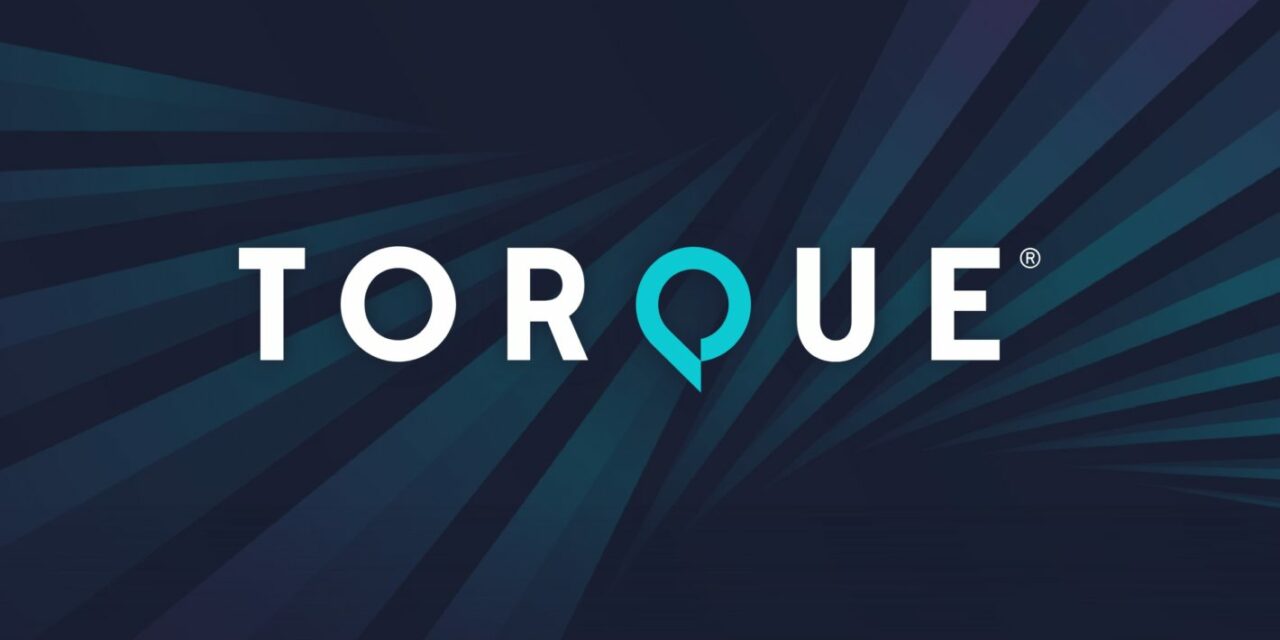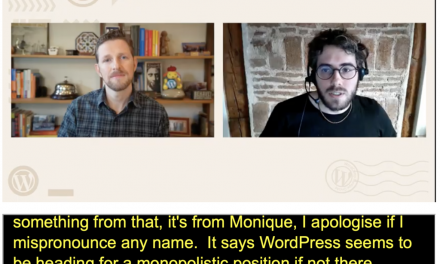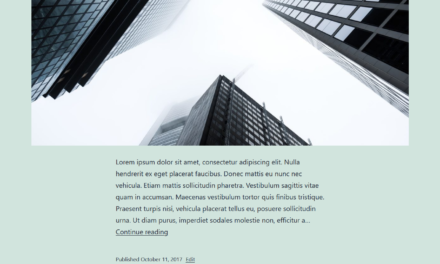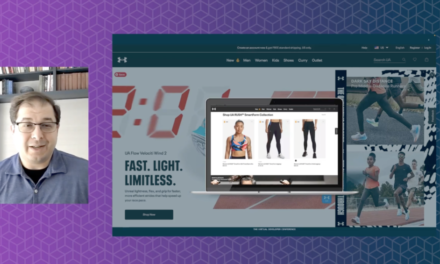Welcome to Press This, the WordPress community podcast from WMR. Each episode features guests from around the community and discussions of the largest issues facing WordPress developers. The following is a transcription of the original recording.
Powered by RedCircle
Doc Pop: You’re listening to Press This, a WordPress Community Podcast on WMR. Each week we spotlight members of the WordPress community. I’m your host, Doc Pop. I support the WordPress community through my role at WP Engine, and my contributions over on TorqueMag.Io where I get to do podcasts and draw cartoons and tutorial videos. Check that out.
You can subscribe to Press This on Red Circle, iTunes, Spotify, your favorite podcasting app or you can download episodes directly at wmr.fm.
Gutenberg was introduced in WordPress 5.0, which was released I believe, late 2018. And in 2021 and 2022, the team began work on Phase Two of Gutenberg. Phase One was just the block editor. Phase Two was site editor and Phase Three is going to be collaborative editing, and collaborative editing is going to be happening soon.
But what’s really exciting is we are wrapping up. We’re coming up to the end of Phase Two. And when I say end of Phase Two, we’re not talking about no more work will be done on the site editor. We’re just talking about the project itself focusing on this stuff. So as that happens, we are starting to see a ton of new features that are going to be coming out in WordPress 6. 3, which the release candidate was just released yesterday and August 8th, I believe is when the official date is, there’s going to be a lot of new stuff coming out to WordPress to kind of wrap up Phase Two of Gutenberg and to help talk about all of these new features that are coming is Justin Tadlock, a WordPress Developer Advocate sponsored by Automattic. Justin is really deep in the woods, and I know he’s excited about talking about some of the new developer features coming to WordPress 6. 3. Before we get into that, Justin, thank you so much for joining us.
Can you just quickly tell us what, what is your history in WordPress again?
Justin Tadlock: All right, so right now, I’m working for Automattic as a Developer Relations Advocate. That means the team goes around and writes documentation. We talk to other developers in the community and just find pain points mostly. So it’s a little bit educational, a little bit outreach, a little bit public relations.
Before that, I was working for WordPress Tavern as a journalist in the space for about two and a half years and long before that I ran my own WordPress plugin and theme shop
Doc Pop: I was a big fan of your writing over on WP Tavern, and I’m super excited to always have you on the show to talk to you about this stuff cuz you’re very passionate about this. And like I said, we’re gonna dive into some of the things you’re really excited about, which is some of the stuff developers should know about 6.3 and the end of Phase Two, I guess, or the wrapping up of Phase Two.
Did I kind of describe the milestones here and kind of what’s happening with 6.3?
Justin Tadlock: I think you got it just right and just to reiterate what you said is that Phase Two is the end of the site customization phase, but it’s not the end of the work. We’re not going to stop and then move to the next phase. And so the work’s going to continue.
Doc Pop: And on a high level, we have lot of polish being added and stuff like that. Is there anything you can tell us on a high level about site improvements that users should know about with 6.3?
Justin Tadlock: Yes, pretty much the entire site editor interface has gotten a bit of an overhaul. You’ll be able to edit your styles, templates, patterns, navigation even from like the site editor sidebar. Pages to, I forget there’s so much that’s added.
Justin Tadlock: I’m really excited about being able to play around with a visual interface. I feel like we’ve kind of reached that point that we’ve been waiting for, for like, 5 years or so. And there’s still a lot more work to do, but it should be really nice for especially non coders to make changes to their site in any way they want.
Doc Pop: Yeah, there’s a lot of stuff coming into the site editor, a lot of it is very visual and in many ways, things are easier to find. I have a feeling there’s going to be a learning curve though. It seems like there’s a lot of changes.
So I think it’s from my experience with 6. 3 so far, just the release candidate, everything’s really nice and it took me a while to find it, but once I found something I could find it right away, the style books, which are always, I thought, pretty hidden, deep. Style books, you can access just from the theme editor page, which is really awesome. And style book is a feature I think a lot of people don’t know about.
I think they don’t. Maybe they do, but it’s a feature that just kind of shows you, here’s how all of your paragraphs are going to look as an overall setting on your site. And here’s how all the sentences and how all the italics and how all your lists and here’s how images look.
It’s just kind of this nice style book is a perfect way to describe it. A nice way to scroll through and kind of get an idea of just in general, how things are going to look, and you can make changes there that will sync up with the rest of your site instead of like going to a post and creating quote block and then making changes.
You can just kind of in the style book, find the quote block and make changes to it there. I’m already deep in the woods and in a bit of minutiae, but now they’ve made this where you can just get to the style book right away from the site editor. So there’s a lot of things like that that I’m excited about.
Justin Tadlock: Yeah, I do want to say, be a little patient when you first install WordPress 6.3 and you are using a block theme. It is a little bit of a learning curve, but I think overall it’s a better experience. It’s just going to be relearning things you already thought you knew.
In terms of style book, it’s easier access to that. I want users to be customizing their styles from a global level and having that exposed, or easier to find will be generally better. I’d rather them not be customizing blocks within a page like changing colors and stuff.
That can be a long term bad thing for your site, being stuck with that red in the middle of a post and at a global level, you should have a blue. So I think exposing more people to the site editor and the global styles interface should kind of help them do things, what you might call the correct way.
Doc Pop: I’m going to talk about one of my favorite features, and then I think after this break, we’ll get in and dive into things you think developers should know about. But I just want to talk about something. I think this is a universal thing that everyone’s going to love.
There’s a new tool called the Command Palette. And if you’re a Mac user, this is very similar to Spotlight. On a Mac, you hit command, space bar, and you open up this kind of search terminal. It’s just text and you can open anything. You can do pretty much anything from within there. It’s just this universal, super easy to use tool.
And something like that is coming to WordPress 6. 3 is called the Command Palette, and from within a post or anywhere where Gutenberg is open, so like the site editor or post editor. If you hit command K, you are opening up a new, search isn’t quite the right term, but a new search window.
And from there you can type in “New Post” and hit enter and it’ll open a new post or you can find out about some UI, there’s little tutorials and things in there to help you understand UI. So it is a really cool way to quickly navigate through your site. And it’s a huge change.
Just like when I learned Spotlight for using Mac, I think I’m going to be hitting Command K all the time when I’m in the post editor or in the site editor, is this a thing you’ve played around with yet?
Justin Tadlock: Yeah I’ve played around with, of course, I’m just not sure about it yet, but I see a lot of potential for the future with this. I see potential for plugin developers to extend this. So, for me, it’s just going to be about waiting and seeing what the feedback is, and I think it has potential.
Doc Pop: Well, it took me some getting used to because the first thing I wanted to do was like, add a new plugin, but you really have to think about it as a spotlight tool for Gutenberg. If you can’t do it in Gutenberg, which the plugin page and a plugin downloads, that’s not Gutenberg, that’s just kind of like another, old school WordPress site, so you can’t quite access those features yet.
But once you can kind of think about what is something where blocks are visible, if you can think about it that way, then you can access those things. And then there are parts like I might want to hit Command K and then try to make a change to WooCommerce. But you can’t Command K that that’s a different thing, but maybe in the future that could be something that comes out.
We are already at our first break, we’re going to take a quick commercial break. And when we come back, we’re going to keep talking with Justin Tadlock.I’ve talked too much at the beginning about what I’m excited about. We’re going to give Justin a chance to talk about what he thinks developers need to know about WordPress 6.3. So stay tuned for more Press This.
Welcome back to Press This, a WordPress community podcast. I’m your host, Doc, and I’m talking to Justin Tadlock, a WordPress Developer Advocate Sponsored by Automattic. He’s here to tell us about WordPress 6. 3. And we talked about the big changes that a lot of users are going to see and the site editor. Justin, tell us about some things that you’re excited about that aren’t going to be something that a user like me is going to encounter, but you think is going to make a huge difference in 6. 3.
Justin Tadlock: I think all features eventually are user features, even if they allow developers to build awesome things for users. One of my favorite things I’ve been playing around with, are the changes to the post template block, which is wrapped by the query loop block.
We have layout support. It has like true grid support, CSS grid. So that opens up a world of possibilities for theme authors to add custom styles that were not as easily done with the previous CSS Flexbox model and there’s a gap support. Which are just like the spacing between posts and those were kind of hard to do.
They’re such simple things that we wonder why we didn’t have them a year ago? But these things are also available in the user interface, so users can more easily change how their query loops or output, when they want to show a list of posts or a grid of posts. As a theme author, primarily that is one of my favorite features.
Doc Pop: I heard about something. I don’t know if that’s coming in 6.3. So maybe this is off. I heard that theme developers might be able to ship a site with plugins not viewable to people who get the page. So like if I’m an agency designing a site for someone, and maybe I don’t want them to have access to the really high level stuff that could break the site, that I could hide those plugins from them, is that something coming in 6.3, is that something discussing now that that’ll be coming in a future version?
Justin Tadlock: I know there’s a new plugin list filter hook. ‘m assuming you may be able to hide things with that. I would not recommend hiding things there. That sounds like bad business. If you have a client that shouldn’t access plugins, then I would recommend doing that through the permissions system, rather than trying to filter out and hide things.
Doc Pop: Mm
Justin Tadlock: There are different ways to go about that. That may have been what you’ve seen, the new filter hook available there. Otherwise, I don’t know.
Doc Pop: There are performance improvements coming to WordPress 6.3. There’s 170 plus performance updates, including defer and async support for the scripts API and fetch priority support for images.
Now, the fetch priority, I know about that one. That’s basically, if you’re trying to appease the Google gods and get that premium Core Web Vitals, you want to be able to have some images load faster than others. And you want to be able to sometimes say, “Hey, this is the image that’s going to be at the top of the page. Please load it first.” Because Google punishes you if images load kind of out of order, if your page kind of changes, size or moves a lot, was there a performance boost that you’re excited about in 6.3?
Justin Tadlock: The fetch priority attribute, which is the thing you were just talking about is probably the most prominent, at least from a user-facing standpoint. Mostly I could rant about how we’re making our web pages so large and untenable with the image sizes and video sizes and stuff. And that’s why we need all these features. But I’ll refrain from going on a rant about that.
But there are other improvements around the cache API, file system API. I think there were 178 there. There’s so many just minor improvements to performance, and they really don’t get highlighted enough compared to some of the bigger features that are in your face. And I think the metadata API had some improvements too.
Doc Pop: What about image lazy loading? Is that part of the fetch request?
Justin Tadlock: That will work alongside the lazy loading process. So you might lazy load all your images on your page, but that first hero image, you want it to load early. But like we’ve had lazy loading for a while. The code under the hood I believe has changed for how a lot of that’s handled. I’d have to dig into that a bit more to uh to know for sure
Doc Pop: I also see emoji loader listed as a performance enhancer. Do you know anything about this? I’m assuming it’s maybe you can turn off emoji if you’re not using them, but maybe it’s something different.
Justin Tadlock: This one I don’t know about, I always disable emoji script for all of my websites because everybody has emoji on their phone and computers nowadays.
Doc Pop: So those are some of the things that are coming in 6.3. I think that there are some things that we can go back and talk about like some of the smaller things happening. Style revisions is one that might be a big deal for users. Is that one that you can explain?
Justin Tadlock: I don’t know much more than that. It’s just going to save your revisions like a post or page.
Doc Pop: Yeah, it seems I didn’t get a chance to play with it too much because I just installed the beta today and it kind of only works after you’ve installed the beta, so I don’t have much history. But from what I could gather, style revisions is going to give you the ability to see a timeline of your site’s theme, for instance, and you can go back to how your site used to look in March, if you had 6.3 or higher or whatever enabled.
And you could go and apparently not just revert, not just like go back to a saved version, which I could do with my host, but this is actually go back and just take that background and not all the other changes.
So kind of go back in time and select certain things you like and make those changes again without having to worry about, well, if I go back two weeks, I’ll lose all this post history or something. It’s not working like that. So that’s a pretty cool system.
Justin Tadlock: Oh yeah, that sounds cool. It’s one thing I just haven’t played around with much on my own but I could see it really being super useful for people working within the site editor. I’m making code changes on my site, so it’s so hard for me to test those things from just a user standpoint sometimes.
Doc Pop: What is the biggest improvement you’ve seen? Well, and you’ve also said because you’re bleeding edge, you have a hard time knowing sometimes what version you’re playing around in, but what would you say is the single biggest new feature in 6.3?
Justin Tadlock: The single biggest feature to me is just the change to the opening up of the site editor, the interface there, and just having easier access. But within the scope of that, I’m really enjoying, editing navigation from the sidebar instead of the content canvas of the editor.
Doc Pop: Mmm-hmm.
Justin Tadlock: It feels a little bit more like it did before the site editor, when we had a menu screen. That has been one of my personal pet peeves, is navigation management. The fact that I’m actually enjoying it a little bit is great because it means the core contributors are doing a great job with it.
Doc Pop: Yeah. And so as a note, it sounds like one of the things that’s been tweaked, in the site editor in terms of the navigation is that sometimes to access the Style Book, for instance, you had to go down a certain path, but to access another feature, you had to be in a different area.
And now you can probably more cohesively get to the Style Book from the same place that you could get to the other things. You don’t have to switch around as much. You can access everything from the navigation menu. Does that sound accurate?
Justin Tadlock: Yeah, and then plus you have the Command Palette also thrown in the mix. So once everybody learns that you should be able to navigate any way you want, and get the places really fast. Kind of touching on the Command Palette thing again, I think I will be a lot more excited about that when the entire WordPress administration interface is run off the WordPress blocker component system.
We still have a long way to go, but hopefully in Phase Three, we’ll get there.
Doc Pop: And you’re talking about kind of going back to what I was saying, where plugins don’t use that system, but you’re saying eventually everything should be consistently using the same system.
Justin Tadlock: Eventually that’s the plan, I hope.
Doc Pop: Right on. Well, we’re going to take another fast break. And when we come back, we’re going to wrap up our conversation with Justin Tedlock about WordPress 6.3 and the book ending of Gutenberg Phase Two. So stay tuned for more.
Doc Pop: Welcome back to Press This, a WordPress community podcast. I’m your host Doc Pop. I’m talking to Justin Tadlock today. And right before that last break, I talked about book ending Gutenberg Phase Two, because this is a thing we don’t want people to think that Phase Two is done. It can always change and grow.
So rather than coming to an end, I tend to think of it as like little bookends that you can kind of move even though we’re going to start working on Phase Three soon, there’s still room for us to move those bookends if we do add stuff into Phase Two, I hope that makes sense.
And with Phase Three coming really soon, we’re going to be having some big changes. Collaborative editing is going to be the overall thing. Justin, they just started, I think a week ago, publicly talking about how they’re going to think about Phase Three. Is there anything you can tell people who are listening, who are very excited about collaboratively editing a site or collaboratively editing a post
Justin Tadlock: Yeah, so I almost don’t like the name of the phase because it encompasses so much more than just saying two people can edit a post at the same time. Hopefully, we’ll get things like the post list tables overhauled, where you edit posts, and bring them up to use the WordPress component system that might mean things like faster loading, finding documents you need to edit faster.
There’ll be an overhaul on the media library, which is long overdue and I always think about it in terms of news editing, where you’ll have an editor and a writer together working on a post at the same time. But there’s also a huge potential for client work. Imagine you’re an agency and you get on a call with the client, you both log in to your demo sites and you could sit there with a client and walk them through the design live and maybe even make edits together, you can collaboratively edit with clients and I think there’s a lot of excitement about that.
Doc Pop: With that example, I can totally imagine the client previewing a site that’s still in construction, the client can go and make some tweaks to the copy in real time and maybe upload a current image of the storefront and the developer can make sure that if there’s any changes visually, they needs to happen, like color palettes, or width of blocks, or whatever that those can happen.
That just sounds super cool for agencies working with a shop owner in the future.
Justin Tadlock: I feel like you might get rid of some of the back and forth. Send me what you think and then you send it back and that kind of back and forth can, depending on like how you work, that can be kind of draining, demotivating during the process and it just wastes time. But anything where you can collaborate at the same time, it just speeds up what you’re doing and you can go out and make more money the faster you can work.
Doc Pop: I guess on that note, let’s bring this conversation to a close, just as a reminder WordPress 6.3, which will be the book ending of Phase Two, is coming August 8, which will give you plenty of time, a couple of weeks before WordCamp US to dig around and play with it. And if you have any questions, I’m sure there’s going to be some awesome talks at WordCamp US about some of the new features and also lots of people to ask questions.
And speaking of Justin, are you going to be at WordCamp us this year?
Justin Tadlock: Unfortunately, not this year. I’m hoping for next year.
Doc Pop: Right on. Well if people do want to follow the projects you’re working on, what’s a good place to send people to do that?
Justin Tadlock: You can always follow me, Justin Tadlock on Twitter. But if I can, I would just like to plug the WordPress developer blog. That’s where I do a lot of my writing and several of my teammates, but we’re always looking for contributors.
Doc Pop: Yeah, absolutely. Is there any topic that you hope someone will volunteer to write about?
Justin Tadlock: Anything around design development and it could be as simple building something in the site editor to extremely complex development topics field is wide open.
Doc Pop: That’s awesome. Well, thank you so much for joining me today, Justin. I’m super excited about the work the team is doing on 6.3. Everything I played with so far has been excellent. So kudos to everyone working on that and a great job on the developer blog too. So thanks for volunteering and working on that.
Doc Pop: Thanks for listening to Press This, a WordPress community podcast on WMR. Once again, my name’s Doc and you can follow my adventures with Torque magazine over on Twitter @thetorquemag or you can go to torquemag.io where we contribute tutorials and videos and interviews like this every day. So check out torquemag.io or follow us on Twitter. You can subscribe to Press This on Red Circle, iTunes, Spotify, or you can download it directly at wmr.fm each week. I’m your host Doctor Popular I support the WordPress community through my role at WP Engine. And I love to spotlight members of the community each and every week on Press This.











